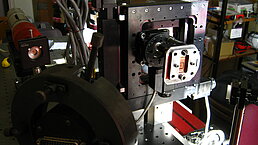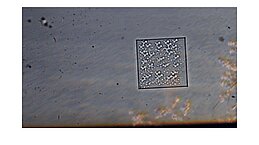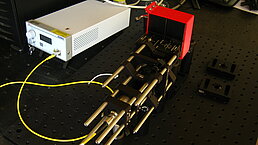Research aress of the Laboratory of Visual Perception include: the optical quality of different optical systems including a human; the optical properties of materials used in the vision science; various light sources and their influence on visual perception. In the laboratory, various visual stimuli for studies on visual psychophysics are designed. The laboratory connects together materials science, vision science and optometry.
Currently, studies on how to reduce the influence of vitreous floaters on visual perception are carried out. These floaters are a widespread entoptic phenomenon. In the Laboratory of Visual Perception, research in aberrometry is also going on. The goal of this research is design a new type of wavefront sensor that has advantages over the current solutions. Innovative light sources are also studied and customized to seasonal chanes in illumination.
| Scientific degree | Name Surname | Position | Contact information |
|---|---|---|---|
| Dr.phys. | Sergejs Fomins | Head of the laboratory and Leading researcher | Sergejs.Fomins |
| Dr.phys. | Varis Karitāns | Leading researcher | Varis.Karitans 29794940 |
| Dr.habil.phys. | Māris Ozoliņš | Leading researcher | Maris.Ozolins 67260868 |
| Renārs Trukša | Laboratory Assistant | Renars.Truksa | |
| Dr.phys. | Paulis Paulins | Laboratory Assistant | Paulis.Paulins |
| Anna Santosa | Laboratory Assistant | Anna.Santosa | |
| Anastasija Nikolajeva | Laboratory Assistant | Anastasija.Nikolajeva |
The main research area of the Laboratory is studies in materials science essential in creation of visual stimuli, in transfer of optical information, and studies of optical properties of eye structure. Visual perception is based on processing electrical neural information at various levels of neural activity. Laboratory is trying to find synergies between material science (physics), vision research (perception) and everyday optometry (profession).
Human vision is a complex phenomenon. Its optical part is essential, however optical image stays only at the very beginning of the visual pathway and information processing in the cortex. We see with our brains, and as a result in some challenging cases it is very hard for us to accept the final outcome.
In the laboratory optical systems with optical properties analogous to those of a living eye and with optical media formed on the basis of biological tissue are being developed. The wavefront aberrations of a cornea and lens of living eyes and model eyes are studied . Various methods used to correct these aberrations are also studied. These methods involve different optical systems, for example, adaptive optics, usual rigid lenses, soft contact lenses, custom contact lenses. In the laboratory new generation wavefront sensors and adaptive optics systems are being developed for wavefront analysis and correction. Such systems are being developed for biologists and astronomers to satisfy the needs of both amateurs and professionals.
Entoptic phenomena of an eye are simulated and studied using eye models with microfluidics systems. The goal is to develop a non-invasive optical system and method to reduce/cancel the undesired effects of vitreous floaters. Vitreous floaters manifest themselves are chains, bubbles and other structures floating in the field of view. These structures are essentially transparent phase diffraction gratings. Another research area is characterizing the illumination of various visual stimuli and their economy and ergonomics. Changes in seasonal illumination and spectra of custom illuminators suited for these changes are studied. The impact of the illuminators on the visual system is analyzed.
Active projects:
European Regional Development Fund (LIAA administrated)
New generation wavefront sensors based on the method of coded diffraction patterns (2018-2021)
Accomplished projects:
European Social Fund
Postdoctoral
Spain:
- Complutense University of Madrid (the contact person: prof. M. C. Puel).
- University of Murcia, Laboratory of Optics (the contact person: prof. H. M. Bueno).
Sweden:
- Sweden Chalmers TH (the contact person: prof. L. Komitov).
Norway:
- Buskerud high-scool, Institute of Optometry (the contact person: prof. J. R. Bruenich).
Finland:
- University of Eastern Finland, Colour Research Laboratory (the contact person: prof. J. Parkkinen).
Germany:
- Dortmund University, Institute of Work Physiology (the contact person: dr. ing. W. Jashinski).
France:
- Clermont-Ferrand Laboratory of Regional Roads (the contact person: dr. M. Colomb).
United Kingdom:
- University of Cardiff, The School of Optometry and Vision science (the contact person: dr. M. Rozanowska).
Ireland:
- University College Dublin, Laboratory of Optics and Advanced Optical Imaging (the contact person: B. Vohnsen).
V. Karitans, E. Nitiss, A. Tokmakovs, K. Pudzs. “Optical phase retrieval using four rotated versions of a single binary mask – simulation results,” Proc. SPIE 106940C, 71421B-71421B-8 (2018); DOI: 10.1117/12.2311861; (Scopus).
V. Karitans, N. Lesina, E. Kassaliete, A. Svede, I. Laicane, L. Ekimane, M. Ozolins, G. Krumina, “Measuring the refractive state of an eye based on the intensity of the retinal reflex,” pieņemts publicēšanai žurnālā Journal of Modern optics.
V. Karitans, “Model Eye Incorporating a Manually Tunable Polymer Lens and Microfluidics Chamber for Simulation of Vitreous Floaters,” in Imaging and Applied Optics 2016, (Optical Society of America, 2016), paper IM3F.2.
V. Karitans, L. Jansone, M. Ozolins, G. Krumina, “Validation of a method for measuring the retinal thickness with Shack–Hartmann aberrometry in an artificial eye,” Journal of Modern Optics 62, 662-675 (2015); DOI: 10.1080/09500340.2014.1003253; (Scopus).
V. Karitans, K. Kundzins, E. Laizane, M. Ozolins, L. Ekimane, “Applicability of a binary amplitude mask for creating correctors of higher-order ocular aberrations in a photoresistive layer,” Optical Engineering 51, 078001-078001-7 (2012); DOI: 10.1117/1.OE.51.7.078001; (Scopus).
V. Karitans, M. Ozolins, K. Luse, L. Ekimane, „Presence of spherical aberration in the reference as a possible source of variations in magnitude of measured ocular aberrations,” Optica Applicata 42, 519-532 (2012); DOI: 10.5277/oa120308; (Scopus).
O. Danilenko, M. Ozolinsh, V. Karitans, P. Paulins, ““SmartGlass” obstacles for dynamic inducing of light scattering in vision research experiments,” Medziagotyra 22, 524-529 (2016); (Scopus).
M. Ozolinsh, K. Muizniece, J. Berzinsh, “Chromostereopsis in "virtual reality" adapters with electrically tuneable liquid lens oculars,” Proc. SPIE 10021, 1002109 (2016); DOI: 10.1117/12.2247719 (Scopus).
S. Fomins, R. Truksa, G. Krumina, “Algorithms for skiascopy measurement automatization,” Proc. SPIE 9421, 94210N (2014); DOI: 10.1117/12.2083950; (Scopus).
S. Fomins, M. Ozolinsh, G. Krumina, V. Karitans, “Ferroelectric liquid crystal glasses for amblyopia research,” Integrated Ferroelectrics 103, 10-17 (2008); DOI: 10.1080/10584580802558076 (Scopus).
EU patents Nr. EP2873364 (A “Multispectrally tested, printed colour vision test for the fine evaluation of the degree of deficiency” (authors S. Fomins, M. Ozolins) (application date 15.11.2013, published 20.05.2015) register.epo.org/application
LR Patents Nr.A61B3/18 15103 B, P-15-132 “Method and apparatus for the near triad examination in free space conditions” (authors: G. Krumina, R. Truksa, S. Fomins, A. Svede) (application date 07.12.2015, published 20.04.2016)
LR Patents Nr. LV15012 B , P-13-205 „Apparatus for assessment of visual functions”, (authors: A. Svede, E. Kassaliete, G. Ikaunieks, G. Krumina, I. Lacis, R. Truksa, S. Fomins (application date 6.12.2013, published 20.12.2015.).
Researchers’ night, the seminar “Beta”, Scientific seminars at the ISSP UL, the exhibition “Environment and Energy”.


